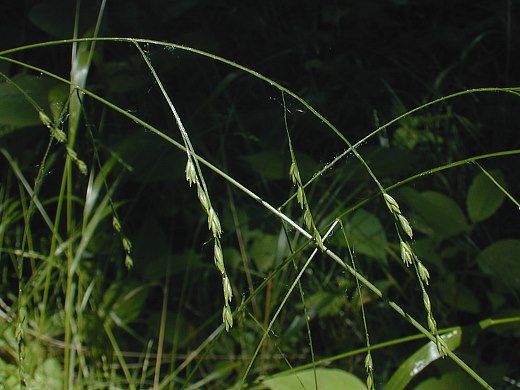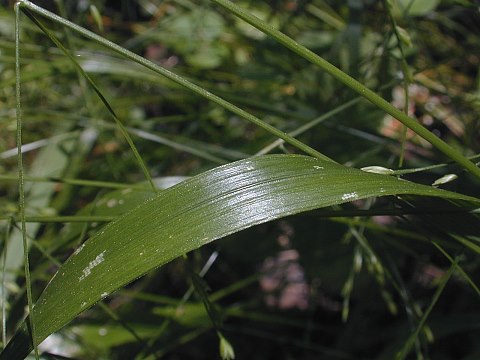Description: This perennial grass produces individual or small tufts of culms with alternate leaves. The unbranched culms are 2-3' long, medium green, terete, and glabrous. The culms are initially erect or ascending, but they have a tendency to sprawl sideways when the spikelets of their inflorescences are produced. The flat leaf blades are up to ½" across, 12" long, and ascending to widely spreading. The upper surface of each leaf blade is shiny dark green, while the lower surface is dull medium green; both surfaces are hairless, or nearly so. Each blade becomes abruptly broad at the base. The leaf sheaths are medium green and glabrous; they are shorter than the internodes. The ligules are short-membranous and rather insignificant.

Each culm
terminates in a panicle of spikelets up to 12" long and about one-half
as much across. This panicle has a very open and lanky appearance
because the small spikelets are concentrated toward the tips of its
long naked branches. These branches are light to medium green,
glabrous, stiff, and slender; they are initially ascending, but later
become widely spreading and drooping. Each spikelet consists of a pair
of glumes and 2-5 lemmas with florets; immature spikelets are light
green, but they later become light tan. The glumes are about 3 mm.
long, lanceolate, and glabrous; they are membranous along their
margins. The lemmas are about 4 mm. long, lanceolate with narrow tips,
and glabrous; the outer surface of each lemma is gently curved. The
blooming period occurs from from late spring to mid-summer. The florets
are pollinated by wind. Disarticulation of the spikelets is above the
glumes; each fertile lemma encloses a small grain. The root system is
fibrous. This grass often forms loose colonies of sprawling plants.
Cultivation:
The preference is partial sun to medium shade, moist to mesic
conditions, and a loamy soil with abundant organic matter. Nodding
Fescue tolerates more shade than most grass species.
Range & Habitat:
The native Nodding Fescue is common throughout Illinois (see Distribution
Map); it may occur in every county. Habitats include moist to
mesic woodlands (especially woodlands with Sugar Maples), small
woodland openings and meadows, areas along woodland paths, and
powerline clearances in wooded areas. This grass can be found in both
degraded and higher quality woodlands; sometimes it strays into
adjacent areas where there is a little more sunlight.

Faunal
Associations:
Information about floral-faunal relationships for this species is
limited. The caterpillars of Hesperia sassacus
(Indian Skipper) feed on the foliage of Nodding Fescue. Generally, Festuca
spp. (Fescue Grasses) are palatable to domesticated
herbivores (e.g., horses, sheep, & cattle), while some birds
and small rodents may eat the seeds of such grasses.
Photographic Location:
A mesic deciduous woodland at Busey Woods in Urbana, Illinois.
Comments:
Nodding Fescue is one of the few native Festuca spp.
(Fescue Grasses) in Illinois. The introduced species tend to be more
densely tufted with more compact inflorescences, and they are usually
found in sunny habitats. A less common native species, Festuca
paradoxa (Clustered Fescue), is very similar in appearance to
Nodding Fescue. The lemmas of Clustered Lemma have tips that are more
blunt and its inflorescence is less lanky and more compact. Another
scientific name that refers to Nodding Fescue is Festuca
obtusa; this latter name is still widely used.